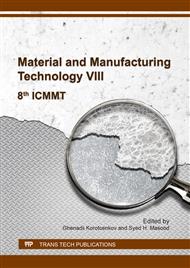[1]
H. Sutanto, S. Wibowo, I. Nurhasanah, E. Hidayanto, H. Hadiyanto, Ag doped ZnO thin films synthesized by spray coating technique for Methylene blue photodegradation under UV irradiation, International Journal of Chemical Engineering, (2016).
DOI: 10.1155/2016/6195326
Google Scholar
[2]
A. Behzadnia, M. Montazer, M. M. Rad, Simultaneous sonosynthesis and sonofabrication of N-doped ZnO/TiO2 core–shell nanocomposite on wool fabric: Introducing various properties specially nano photo bleaching, Ultrasonics Sonochemistry, 27 (2015).
DOI: 10.1016/j.ultsonch.2015.04.017
Google Scholar
[3]
S. Wibowo, H. Sutanto, Preparation and characterization of double layer thin films ZnO/ZnO: Ag for methylene blue photodegradation, AIP Conference Proceedings, 1710 (2016), 4941515.
DOI: 10.1063/1.4941515
Google Scholar
[4]
I. M. P. Silva, G. Byzynski, C. Ribeiroc, E. Longo, Different dye degradation mechanisms for ZnO and ZnO doped with N (ZnO: N), Journal of Molecular Catalysis A: Chemical, 417 (2016) 89–100.
DOI: 10.1016/j.molcata.2016.02.027
Google Scholar
[5]
J. Tian, L. Chen, Y. Yin, X. Wang, P. Wu, Photocatalyst of TiO2/ZnO nano composit film, Surface & Coating Technology, 2004 (2009), 205-214.
Google Scholar
[6]
T. Ivanova, A. Harizanova, T. Koutzarova, B. Vertruyen, Preparation and characterization of ZnO/TiO2 films obtained by sol-gel method, Journal of Non-Crystalline Solids, 375 (2011), 2840-2845.
DOI: 10.1016/j.jnoncrysol.2011.03.019
Google Scholar
[7]
N. Salah, A. Hameed, M. Aslam, M. S. Abdel-wahab, S. S. Babkair, F.S. Bahabri, Flow controlled fabrication of N doped ZnO thin films and estimation of their performance for sunlight photocatalytic decontamination of water, Chemical Engineering Journal, 291 (2016).
DOI: 10.1016/j.cej.2016.01.111
Google Scholar
[8]
W. Xue-wen, L. Zhou, F. Li, ZnO disks loaded with reduced Graphene oxide for the photodegradation of methylene blue, New Carbon Materials, 28(6) (2013), 408–413.
DOI: 10.1016/s1872-5805(13)60090-6
Google Scholar
[9]
M. B. Akin, M. Oner, Photodegradation of methylene blue with sphere-like ZnO particles prepared via aqueous solution, Ceramics International, 39 (2013), 9759–9762.
DOI: 10.1016/j.ceramint.2013.05.024
Google Scholar
[10]
H. Sutanto, I. Nurhasanah, E. Hidayanto, S. Wibowo, Hadiyanto, Synthesis and characterization of ZnO: TiO2 nano composites thin films deposited on glass substrate by sol-gel spray coating technique, AIP Conference Proceedings, 1699 (2015).
DOI: 10.1063/1.4938320
Google Scholar
[11]
R. Chauhan, K. Ashavani, P. C. Ram, Synthesis and characterization of Silver doped ZnO nanoparticles, Journal of Solar Research Library, 2 (2010), 378-385.
Google Scholar
[12]
S. Das, S. Patra, J. P. Kar, A. Roy, A. Ray, J. M. Myoung, Origin of p-type conductivity for N-doped ZnO nanostructure synthesized by MOCVD method, Materials Letters, 161 (2015), 701–704.
DOI: 10.1016/j.matlet.2015.09.075
Google Scholar
[13]
H. Lu, P. Zhou, H. Liu, L. Zhang, Y. Yu, Y. Li, Z. Wang, Effects of Nitrogen and Oxygen partial pressure on the structural and optical properties of ZnO: N thin films prepared by magnetron sputtering, Materials Letters, 165 (2016), 123–126.
DOI: 10.1016/j.matlet.2015.11.105
Google Scholar
[14]
B. M. Rajbongshi, A. Ramchiary, S.K. Samdarshi, Influence of N-Doping on photocatalytic activity of ZnO nano particles under visible light irradiation, Materials Letters, 134 (2014), 111–114.
DOI: 10.1016/j.matlet.2014.07.073
Google Scholar
[15]
C. Wu, Facile one-step synthesis of N-doped ZnO micropolyhedrons for efficient photocatalytic degradation of formaldehyde under visible-light irradiation, Applied Surface Science, 319 (2014), 237–243.
DOI: 10.1016/j.apsusc.2014.04.217
Google Scholar
[16]
E. S. Tuzemen, K. Kara, S. Elagoz, D. K. Takci, I. Altuntas, R. Esen, Structural and electrical properties of nitrogen-doped ZnO thin films, Applied Surface Science, 318 (2014), 157–163.
DOI: 10.1016/j.apsusc.2014.02.118
Google Scholar
[17]
R. Sen, S. Das, K. Das, Microstructural characterization of nanosized Ceria powders by X-ray diffraction analysis, Metallurgical and Materials Transactions A, 42A (2011), 1409-1417.
DOI: 10.1007/s11661-010-0463-4
Google Scholar
[18]
I. Nurhasanah, H. Sutanto, R. Futikhaningtyas, Optical properties of Zn-doped CeO2 nanoparticles as function of Zn content, Advanced Materials Research, 896 (2014), 108-111.
DOI: 10.4028/www.scientific.net/amr.896.108
Google Scholar


